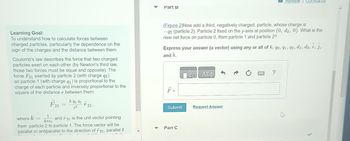
College Physics
11th Edition
ISBN: 9781305952300
Author: Raymond A. Serway, Chris Vuille
Publisher: Cengage Learning
expand_more
expand_more
format_list_bulleted
Concept explainers
Question

Transcribed Image Text:Learning Goal:
To understand how to calculate forces between
charged particles, particularly the dependence on the
sign of the charges and the distance between them.
Coulomb's law describes the force that two charged
particles exert on each other (by Newton's third law,
those two forces must be equal and opposite). The
force F21 exerted by particle 2 (with charge q2)
on particle 1 (with charge q₁) is proportional to the
charge of each particle and inversely proportional to the
square of the distance r between them:
k 92 91
r21.
F21
72
where k =
1
and 21 is the unit vector pointing
4TTEO
from particle 2 to particle 1. The force vector will be
parallel or antiparallel to the direction of f 21, parallel if
Part B
(Figure 2)Now add a third, negatively charged, particle, whose charge is
-92 (particle 2). Particle 2 fixed on the y-axis at position (0, d2, 0). What is the
new net force on particle 0, from particle 1 and particle 2?
Express your answer (a vector) using any or all of k, go, 91, 92, di, d2, i, j,
and k.
F =
Submit
Part C
17 ΑΣΦ
Review Constants
Request Answer
?
Expert Solution
This question has been solved!
Explore an expertly crafted, step-by-step solution for a thorough understanding of key concepts.
This is a popular solution
Trending nowThis is a popular solution!
Step by stepSolved in 3 steps with 3 images

Knowledge Booster
Learn more about
Need a deep-dive on the concept behind this application? Look no further. Learn more about this topic, physics and related others by exploring similar questions and additional content below.Similar questions
- Problem 1. g>0 A charge q > 0 is placed at a distance d above a) the r-y plane. What is the electric flux o through a surface S, infinite in extent, that coincides with the x-y plane? The normal vector for S points along -z, î = -k. (Hint: You can find the answer using Gauss's law, without evaluating any integrals.) right Princeton University The remaining parts of this problem have a uniformly charged (charge density p) insulating spherical shell of outer radius R and inner radius R/2 centered at the origin. b) ( Find Ë(7) everywhere, that is, at r R. Indicate both magnitude and direction. 2arrow_forwardI only need help with question c. Please help. thanksarrow_forwardPlease check my work for 1a and 1b please while also aiding me in answering 1c. k=9x10^9 Nm^2/C^2 1a.What is the net electric force on charge Q3 due to charges Q1 and Q2? (Direction and Magnitude) 1b.What is the net electric force on charge Q2 due to charges Q1 and Q3? (Direction and Magnitude) 1a.What is the net electric force on Point P due to charges Q1, Q2, and Q3? (Direction and Magnitude)arrow_forward
- can you solve only d pleasearrow_forwardProblem 2.32 Two positive point charges, qд and qв (masses mд and må) are at rest, held together by a massless string of length a. Now the string is cut, and the particles fly off in opposite directions. How fast is each one going, when they are far apart?arrow_forwardconsider the parallelepiped with sides: A=3i+2j+k، B=i+j+2k, c=i+3j+3k, then 1-Find the rolume of the paralldepiped 2-Find the area of the face determined by A and B. 3-Find the angle between the vactor C and the plane containing the face determined by A and Barrow_forward
arrow_back_ios
arrow_forward_ios
Recommended textbooks for you
 College PhysicsPhysicsISBN:9781305952300Author:Raymond A. Serway, Chris VuillePublisher:Cengage Learning
College PhysicsPhysicsISBN:9781305952300Author:Raymond A. Serway, Chris VuillePublisher:Cengage Learning University Physics (14th Edition)PhysicsISBN:9780133969290Author:Hugh D. Young, Roger A. FreedmanPublisher:PEARSON
University Physics (14th Edition)PhysicsISBN:9780133969290Author:Hugh D. Young, Roger A. FreedmanPublisher:PEARSON Introduction To Quantum MechanicsPhysicsISBN:9781107189638Author:Griffiths, David J., Schroeter, Darrell F.Publisher:Cambridge University Press
Introduction To Quantum MechanicsPhysicsISBN:9781107189638Author:Griffiths, David J., Schroeter, Darrell F.Publisher:Cambridge University Press Physics for Scientists and EngineersPhysicsISBN:9781337553278Author:Raymond A. Serway, John W. JewettPublisher:Cengage Learning
Physics for Scientists and EngineersPhysicsISBN:9781337553278Author:Raymond A. Serway, John W. JewettPublisher:Cengage Learning Lecture- Tutorials for Introductory AstronomyPhysicsISBN:9780321820464Author:Edward E. Prather, Tim P. Slater, Jeff P. Adams, Gina BrissendenPublisher:Addison-Wesley
Lecture- Tutorials for Introductory AstronomyPhysicsISBN:9780321820464Author:Edward E. Prather, Tim P. Slater, Jeff P. Adams, Gina BrissendenPublisher:Addison-Wesley College Physics: A Strategic Approach (4th Editio...PhysicsISBN:9780134609034Author:Randall D. Knight (Professor Emeritus), Brian Jones, Stuart FieldPublisher:PEARSON
College Physics: A Strategic Approach (4th Editio...PhysicsISBN:9780134609034Author:Randall D. Knight (Professor Emeritus), Brian Jones, Stuart FieldPublisher:PEARSON

College Physics
Physics
ISBN:9781305952300
Author:Raymond A. Serway, Chris Vuille
Publisher:Cengage Learning

University Physics (14th Edition)
Physics
ISBN:9780133969290
Author:Hugh D. Young, Roger A. Freedman
Publisher:PEARSON

Introduction To Quantum Mechanics
Physics
ISBN:9781107189638
Author:Griffiths, David J., Schroeter, Darrell F.
Publisher:Cambridge University Press

Physics for Scientists and Engineers
Physics
ISBN:9781337553278
Author:Raymond A. Serway, John W. Jewett
Publisher:Cengage Learning

Lecture- Tutorials for Introductory Astronomy
Physics
ISBN:9780321820464
Author:Edward E. Prather, Tim P. Slater, Jeff P. Adams, Gina Brissenden
Publisher:Addison-Wesley

College Physics: A Strategic Approach (4th Editio...
Physics
ISBN:9780134609034
Author:Randall D. Knight (Professor Emeritus), Brian Jones, Stuart Field
Publisher:PEARSON